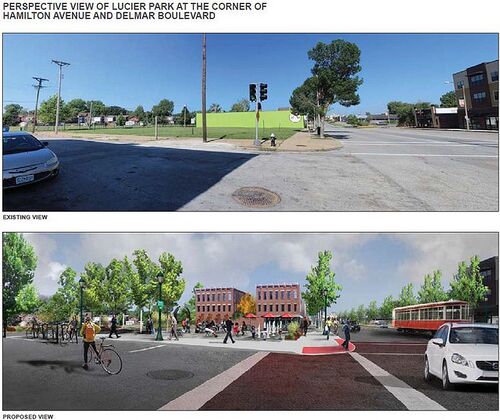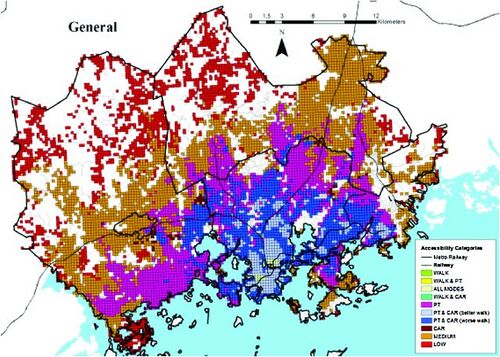Measuring Transportation Performance
| Transportation | |||||||||||||||||||||
|---|---|---|---|---|---|---|---|---|---|---|---|---|---|---|---|---|---|---|---|---|---|

| |||||||||||||||||||||
| Sectors | Transportation | ||||||||||||||||||||
| Contact | Wilfred Pinfold | ||||||||||||||||||||
| Topics |
| ||||||||||||||||||||
Activities
| |||||||||||||||||||||
- Authors
The purpose of this wiki page is to explain the limitations of conventional transportation HKPIs and to promote the use of HKPIs for accessibility of services and resources in a city. The page aims to provide an overview of the benefits of using HKPIs for accessibility, examples of such metrics, and case studies of cities that have successfully implemented them. It also provides recommendations for cities and transportation planners to implement HKPIs for accessibility of services and resources in order to promote social equity and inclusion.
Introduction
The concept of accessibility is an essential aspect of urban planning and transportation, yet it is often overlooked in conventional metrics and indicators used to evaluate a city's transportation system. Conventional transportation metrics such as travel time, traffic flow, and vehicle capacity are designed to measure the efficiency of the transportation system, but they do not take into account the accessibility of services and resources that the transportation system provides.
The lack of consideration for accessibility in transportation planning and decision-making has led to significant disparities in access to critical services and resources, such as healthcare, education, employment, and social services. For example, residents of low-income neighborhoods and marginalized communities may have limited access to public transportation or affordable transportation options, making it difficult for them to reach essential services and resources.
To address these issues and promote social equity and inclusion, there is a growing recognition of the need to shift towards using Holistic Key Performance Indicators1 (HKPIs) for accessibility of services and resources in a city. HKPIs are a set of metrics that evaluate the accessibility of services and resources by measuring factors such as proximity, availability, user satisfaction, diversity, and inclusion.
By using HKPIs for accessibility, cities can obtain a more comprehensive view of the accessibility of services and resources for all residents, including those who are traditionally marginalized or underserved. This approach can help identify and address accessibility barriers and promote the development of more inclusive and equitable transportation systems.
Limitations of conventional transportation HKPIs

Conventional transportation2 HKPIs are designed to measure the efficiency and performance of the transportation system, often focusing on factors such as travel time, traffic flow, vehicle capacity, and infrastructure utilization. However, they overlook the importance of accessibility of services and resources. This can lead to disparities in access to essential services and resources, such as healthcare, education, employment, and social services. Conventional HKPIs may not account for differences in accessibility between different population groups or consider the specific needs of vulnerable populations. By focusing solely on transportation efficiency, conventional HKPIs may perpetuate social inequities and discrimination, failing to promote social equity and inclusion.
For instance, conventional transportation HKPIs often prioritize speed over accessibility, which can result in a transportation system that bypasses low-income neighborhoods, making it difficult for residents to access essential services and resources. Furthermore, conventional transportation HKPIs often measure the number of passengers transported per vehicle, which can lead to a transportation system that prioritizes efficiency over accessibility. This may not adequately serve low-density neighborhoods or areas with limited infrastructure.
Conventional transportation HKPIs can contribute to social inequities3 and discrimination by failing to consider the needs of vulnerable populations, perpetuating an unequal distribution of transportation resources, having a disproportionate impact on marginalized communities, and reinforcing existing power structures. This highlights the importance of using HKPIs for accessibility of services and resources in a city to promote a more comprehensive and equitable approach to transportation planning and decision-making.
Benefits of using HKPIs for accessibility of services and resources
HKPIs for accessibility of services and resources provide a more comprehensive view of a city's accessibility by incorporating a broader range of factors beyond transportation efficiency. These metrics focus on the availability and proximity of essential services and resources, such as healthcare, education, employment, and social services, and how accessible they are to all members of the community, including those who are marginalized or vulnerable.
By measuring accessibility in this way, these HKPIs can provide a more accurate picture of a city's overall accessibility and identify areas that need improvement. HKPIs for accessibility of services and resources can also highlight disparities in accessibility between different population groups and areas of a city. This information can help policymakers and planners identify areas that require additional resources and interventions to improve accessibility and promote social equity.
HKPIs for accessibility of services and resources take into account the needs of all members of the community, particularly those who are vulnerable or marginalized. This approach can promote social justice by ensuring that all members of the community have equal access to essential services and resources, regardless of their income, ability, or geographic location.
Examples of how HKPIs for accessibility of services and resources can help identify and address accessibility barriers include tracking the availability of essential services and resources, measuring the connectivity of different transportation modes, analyzing transit service quality, frequency, and coverage, assessing the accessibility of infrastructure, and analyzing the availability and affordability of transportation options for different population groups.
HKPIs for accessibility of services and resources can promote social equity and inclusion by taking a more comprehensive and holistic approach to transportation planning and decision-making. By focusing on factors beyond just transportation efficiency and performance, such as access to essential services and resources, these HKPIs can help identify and address accessibility barriers and disparities in a more targeted and effective manner.
By prioritizing the development of transportation infrastructure that connects underserved areas with essential services and resources and considering the specific needs of vulnerable populations, HKPIs for accessibility of services and resources can help ensure that transportation systems are accessible and inclusive for all members of the community. Furthermore, HKPIs can help promote social equity and inclusion by ensuring that transportation resources are distributed in an equitable and just manner.
Examples of HKPIs for accessibility of services and resources
Examples of HKPIs for accessibility of services and resources are:
- Proximity of Services: The distance between a location and essential services such as healthcare, education, employment, and social services.
- Availability of Accessible Infrastructure: The percentage of transportation infrastructure, such as sidewalks, curb ramps, and accessible public transportation, that meets accessibility standards4.
- User Satisfaction: The percentage of users who report satisfaction with the accessibility of essential services and resources, including transportation.
- Diversity and Inclusion: The percentage of essential services and resources that are accessible to members of diverse and marginalized communities, including people with disabilities, seniors, and low-income individuals.
- Availability of Information: The percentage of essential services and resources that provide clear and accessible information about accessibility options and accommodations.
- Availability of Alternative Communication Methods: The percentage of essential services and resources that provide alternative communication methods, such as sign language interpretation, to accommodate individuals with communication disabilities.
- Availability of Accommodations: The percentage of essential services and resources that provide accommodations, such as accessible seating or assistive technology, to accommodate individuals with disabilities.
These HKPIs can be used to evaluate the accessibility of services and resources in a city by measuring the availability and accessibility of essential services and resources for all members of the community. For example:
- Proximity of Services: By measuring the distance between essential services and resources and different neighborhoods in a city, policymakers and planners can identify areas that lack accessibility and allocate resources to improve accessibility.
- Availability of Accessible Infrastructure: By measuring the percentage of transportation infrastructure that meets accessibility standards, policymakers and planners can identify areas that require additional investment to improve accessibility.
- User Satisfaction: By surveying users of essential services and resources, policymakers and planners can identify areas that need improvement and prioritize investments to improve user satisfaction.
- Diversity and Inclusion: By measuring the percentage of essential services and resources that are accessible to diverse and marginalized communities, policymakers and planners can identify areas that require additional resources and interventions to improve accessibility and promote social equity.
- Availability of Information: By measuring the percentage of essential services and resources that provide clear and accessible information about accessibility options and accommodations, policymakers and planners can identify areas that require additional investment to improve accessibility and provide better information to users.
- Availability of Alternative Communication Methods: By measuring the percentage of essential services and resources that provide alternative communication methods, policymakers and planners can identify areas that require additional investment to improve accessibility for individuals with communication disabilities.
- Availability of Accommodations: By measuring the percentage of essential services and resources that provide accommodations, policymakers and planners can identify areas that require additional investment to improve accessibility for individuals with disabilities and promote social equity.
Case studies of cities using HKPIs for accessibility of services and resources

One example of a city that has implemented HKPIs for accessibility of services and resources is Helsinki Finland. The city has developed an accessibility map5 that provides information on the accessibility of public spaces, transportation, and services for people with disabilities. The map is based on user-generated data and includes information on the availability of accessible parking, public restrooms, and accessible public transportation. The city also uses HKPIs to evaluate the accessibility of its public transportation system, such as measuring the percentage of public transportation stops that are accessible to people with disabilities and the percentage of vehicles that are equipped with wheelchair ramps.
London England is another city that has implemented HKPIs for accessibility of services and resources. The city's transport agency, Transport for London, has developed a set of accessibility indicators6 that are used to evaluate the accessibility of the city's transportation system. These indicators include the availability of accessible parking, the number of accessible public transportation stops, and the number of buses and trains that are equipped with wheelchair ramps. The city also uses HKPIs to evaluate the accessibility of its pedestrian infrastructure, such as measuring the number of pedestrian crossings and the availability of tactile paving for people with visual impairments.
New York NY is also using HKPIs to improve the accessibility of its transportation system. The city's Metropolitan Transportation Authority (MTA) has developed a set of accessibility indicators that are used to evaluate the accessibility of the city's subway and bus systems. These indicators include the availability of elevators and escalators at subway stations, the width of subway car doors, and the height of subway platform edges. The MTA also uses HKPIs to evaluate the accessibility of its bus system, such as measuring the percentage of buses that are equipped with wheelchair ramps and the number of bus stops that are accessible to people with disabilities.
In all of these cities, HKPIs for accessibility of services and resources are being used to identify areas where accessibility improvements are needed and to track progress over time. By using data to inform decision-making, these cities are able to allocate resources in a more targeted and effective manner, ultimately improving the accessibility of services and resources for their residents.
Recommendations for using HKPIs for accessibility of services and resources
Here are some recommendations for cities and transportation planners to implement HKPIs for accessibility of services and resources:
- Define and prioritize accessibility: Cities and transportation planners should define and prioritize accessibility as a key performance indicator. Accessibility should be considered alongside other traditional transportation performance indicators, such as efficiency and safety, to ensure a more comprehensive approach to transportation planning.
- Involve community stakeholders: Community stakeholders, particularly those who are vulnerable or marginalized, should be involved in the development and implementation of HKPIs for accessibility of services and resources. This can help ensure that the HKPIs are sensitive to the needs of the community and that transportation plans are developed in collaboration with those who will be most impacted by them.
- Use data-driven approaches: HKPIs for accessibility of services and resources should be developed using data-driven approaches. This can help identify areas of a city that are underserved and where additional resources are needed to improve accessibility. Data sources may include demographic data, travel behavior data, and service availability data.
- Monitor and evaluate performance: Once HKPIs for accessibility of services and resources are implemented, cities and transportation planners should regularly monitor and evaluate their performance. This can help identify areas that require additional resources and interventions to improve accessibility and promote social equity.
- Invest in infrastructure: To improve accessibility, cities and transportation planners should invest in infrastructure that connects underserved areas with essential services and resources. This may include public transit, bike lanes, sidewalks, and pedestrian crossings.
- Ensure diversity and inclusion: HKPIs for accessibility of services and resources should ensure diversity and inclusion in transportation planning. This may involve considering the needs of different population groups, such as seniors, persons with disabilities, and low-income individuals, and ensuring that transportation services and resources are accessible and inclusive for all members of the community.
By implementing these recommendations, cities and transportation planners can improve the accessibility of services and resources for all residents. This can promote social equity and inclusion, reduce transportation-related social disparities, and ensure that all members of the community have equal access to essential services and resources.
Conclusion
This page highlights the limitations of conventional transportation HKPIs in measuring the accessibility of essential services and resources. Conventional HKPIs tend to prioritize transportation efficiency over accessibility, leading to disparities in access to services and resources, particularly for vulnerable populations.
To address this issue, HKPIs for accessibility of services and resources have been developed to provide a more comprehensive and inclusive approach to transportation planning and decision-making. These HKPIs focus on the availability and proximity of essential services and resources and how accessible they are to all members of the community, regardless of their income, ability, or geographic location.
The use of HKPIs for accessibility of services and resources is essential in promoting social equity and inclusion in cities. By incorporating a broader range of factors beyond transportation efficiency, these metrics can identify disparities in accessibility between different population groups and areas of a city. This information can help policymakers and planners identify areas that require additional resources and interventions to improve accessibility and promote social equity.
Several cities, such as Helsinki, London, and New York City, have implemented HKPIs for accessibility of services and resources to improve the accessibility of services and resources for their residents. Recommendations for cities and transportation planners to implement HKPIs for accessibility of services and resources include identifying key stakeholders, collecting relevant data, and establishing performance metrics to measure progress.
It is essential for readers to consider using HKPIs for accessibility of services and resources in their own work to promote social equity and inclusion in their communities. By taking a more comprehensive and inclusive approach to transportation planning and decision-making, we can ensure that all members of the community have equal access to essential services and resources, regardless of their income, ability, or geographic location.
Notes
- Minako Hara, Tomomi Nagao, Shinsuke Hannoe, Jiro Nakamura. "New Key Performance Indicators for a Smart Sustainable City".
 , MDPI AG, 2016, Vol = 8, Issue = 3, pp. 206, DOI = 10.3390/su8030206.
, MDPI AG, 2016, Vol = 8, Issue = 3, pp. 206, DOI = 10.3390/su8030206. - Silvana Secinaro, Valerio Brescia, Federico Lanzalonga, Gabriele Santoro. "Smart city reporting: A bibliometric and structured literature review analysis to identify technological opportunities and challenges for sustainable development". Elsevier BV, 2022, Vol = 149, pp. 296-313, DOI = 10.1016/j.jbusres.2022.05.032.
- "CHAOS Report: Decision Latency Theory: It Is All About the Interval.". Standish Group, 2018, .
- Dittmar, H, et.al.. "The new transit town: Best practices in transit-oriented development". Island Press, 2012, ISBN = 1-55963-117-1, .
References
- ^ David Wollman. "Smart Cities and Communities: A Key Performance Indicators Framework".
 , National Institute of Standards and Technology, 2022, DOI = 10.6028/nist.sp.1900-206-upd1.
, National Institute of Standards and Technology, 2022, DOI = 10.6028/nist.sp.1900-206-upd1. - ^ Mishra, S, et.al.. "Performance indicators for public transit connectivity in multi-modal transportation networks". http://www.sciencedirect.com/science/article/pii/S0965856412000705, 2012-08-01, Vol = 46, Issue = 7, pp. 1066–1085, DOI = 10.1016/j.tra.2012.04.006.
- ^ "Measuring Smart Cities' Performance - Do smart cities benefit everyone?". https://www.oecd.org/env/indicators-modelling-outlooks/oecdenvironmentaloutlookto2050theconsequencesofinaction-keyfactsandfigures.htm,
 , OECD,, 2020, .
, OECD,, 2020, . - ^ ISO-International Organization for Standardization,. "ISO - #worldsmartcity". http://www.iso.org/sites/worldsmartcity/, .
- ^ X. Albacete, T. Toivonen, M. Salonen, P. Saarsalmi, M. Kolehmainen. "Resident group specific accessibility analysis and implications for the Great Helsinki Region using Structural Accessibility Layer".
 , Elsevier BV, 2017, Vol = 5, Issue = 1, pp. 87-101, DOI = 10.1016/j.cstp.2016.12.001.
, Elsevier BV, 2017, Vol = 5, Issue = 1, pp. 87-101, DOI = 10.1016/j.cstp.2016.12.001. - ^ "London's Accessibility Indicators".
 , Organisation for Economic Co-Operation and Development (OECD), 2018, DOI = 10.1787/cb74d5d5-en.
, Organisation for Economic Co-Operation and Development (OECD), 2018, DOI = 10.1787/cb74d5d5-en.




